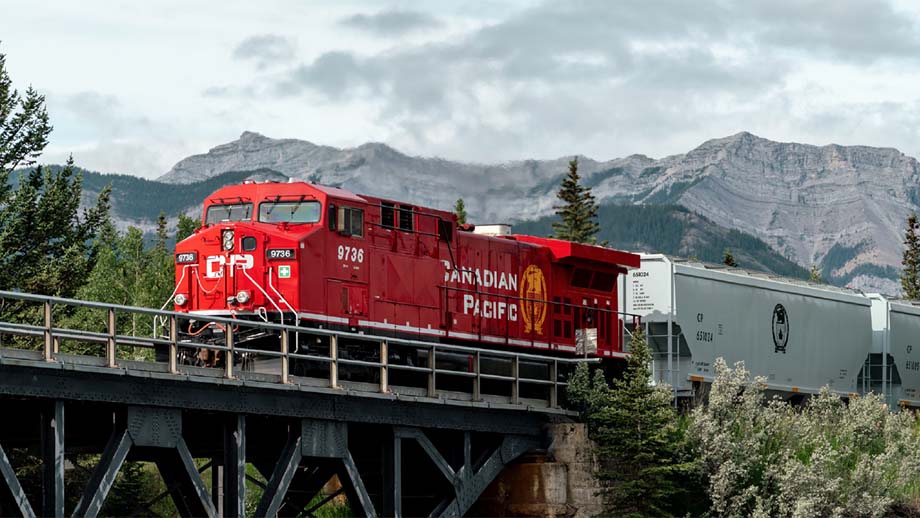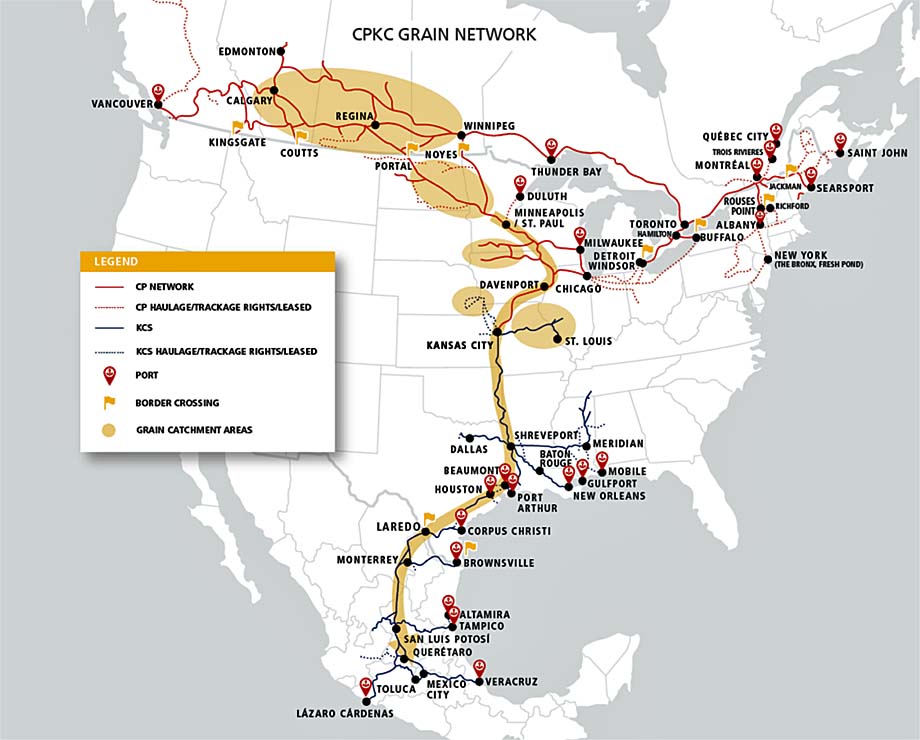
New York New York USA
Calgary Alberta - Since 2018, the Canadian government, through changes in Section 151.01(1) of the
Canada Transportation Act, has required Canada's railroads to publish grain movement plans for the forthcoming crop
year.
Grain is crucial to Canada's economy, as such its transportation is heavily regulated, much more so than in the
U.S.
Canadian Pacific has just published its 2022-2023 Grain Service Outlook Report, which "provides an assessment of
CP's ability to move grain during the upcoming 2022–2023 crop year, taking into account the total volume of grain
expected to be moved," and also "describes the process that CP undertakes each year to prepare for, and
respond to, market demand for grain transportation."
"Regrettably, the 2021-2022 Western Canadian grain crop was the smallest in more than a decade as a result of
severe drought conditions throughout the Prairies in summer 2021," CP President and CEO Keith Creel
said.
"Our total volume of Canadian grain and grain products transported during the 2021-2022 crop year is down
approximately 43 percent compared to 2020-2021's record-breaking volume of 30.62 million metric tons (MMT). CP had
prepared the railway to transport much higher volumes of grain, but unfortunately, there was not more grain to move.
On a positive note, working closely with our customers, CP successfully responded to surging demand for the
transportation of corn and grain products from the United States into the Canadian Prairies to supply cattle feed this
past winter. We delivered more than 35,400 carloads, which represents an increase of 33,200 carloads or 1,600 percent
compared to 2020-2021. This required the creation of an entirely new supply chain, demonstrating CP's ability to be
nimble and respond quickly to changing market conditions."
Looking ahead, Creel said that Statistics Canada "is forecasting a more typical Canadian grain crop this year. We
are hopeful that there will be more grain to move. CP is once again in a strong position to meet the transportation
needs of our grain customers and the broader Canadian economy during the upcoming 2022-2023 crop
year."
Creel also noted that CP anticipates securing regulatory approval from the Surface Transportation Board to combine with
KCS to create CPKC, North Americas' first transnational railroad connecting Canada, the U.S., and Mexico.
The CPKC network will be "a transformative opportunity for Canada's grain shippers because it will directly
connect production-rich CP origins in the Canadian Prairies to new export destinations in the U.S. and
Mexico.

Statistics Canada is forecasting this year's total crop at 93 MMT, and Western Canada's grain production is estimated
at 71 MMT, which is above the previous five-year average of 69 MMT and is "consistent with the expectation of our
customers," CP said.
The railroad expects to move more than 30 MMT of grain and grain products, with capacity to move more, "subject to
market demand."
CP cautioned that it "anticipates a slow start to the crop year as the anticipated carry-in volume of Canadian
grain is approximately 6 MMT, the lowest carry-in volume in more than 15 years, and seeding is delayed across most of
the Prairies. The low carry-in volume is primarily driven by the 10 year low grain crop and high global demand for
Canadian grain. The typical average carry-in volume is 11 MMT."
In addition to these supply forecasts, CP anticipates moving, on average, 1,050 cars of grain products each week in
customer-supplied equipment through most of the upcoming crop year, subject to market demand.
On a weekly tonnage basis, this equates to 683,850 metric tons during the spring, summer, and fall periods, 523,800 per
week during the winter months when the Port of Thunder Bay is closed.
To handle the traffic, CP plans to make available approximately 1,100 locomotives and 15,500 grain hopper cars
throughout the 2022–2023 crop year, supply 6,000 grain hopper cars per week to country elevators, from August through
mid-December, and from April to July, also subject to market demand.
During the winter months when the Port of Thunder Bay is closed, CP plans to supply 4,350 grain hopper cars each week,
subject to market demand.

CP said it plans to hire 2,500 employees this year, on top of the more than 1,000 operations personnel hired already
this year.
This includes 1,100 operating employees and 500 engineering employees in Canada this year.
Currently, there are more than 730 new employees in various stages of training across Canada.
For the 2022-2023 crop year, CP plans to have approximately 4,000 to 4,200 operations employees deployed across the
network, including approximately 3,000 to 3,200 operations employees in Canada, subject to market
demand.
Grain-dedicated rail car improvements include completion of a $500 million multi-year investment to purchase 5,900 new
high-capacity grain hopper cars, bring the total to 7,300 new CP-owned and leased units in service by the end of
2022.
These cars are shorter, wider, and lighter than the old Government of Canada cars they replace, with a three-pocket
configuration that can be loaded and unloaded more efficiently than the four-pocket design of the older
model.
This equates to 15 percent greater volume and 10 percent greater GRL (Gross Rail Load), as more cars (118 vs. 112) can
be used on a train of the same length, 7,000 feet.
"The new hopper cars are already providing significant capacity gains for Canada's grain supply chain," CP
said, adding that its 8,500-foot High-Efficiency Product (HEP) train model, together with the new high-capacity grain
hopper cars," is responsible for delivering an increase of more than 40 percent for the volume of grain
transported per train."
HEP trains consist of 147 of the new high-capacity hoppers.
CP developed an online supply chain scorecard (below) that reports the railroad's performance for each previous week in
the grain crop year, and it includes when needed, detailed information on internal or external factors affecting grain
transportation on its network.
The scorecard, CP said, is "an effort to increase the transparency of our weekly grain performance in
Canada."

Author unknown.
(likely no image with original article)
(usually because it's been seen before)
provisions in Section 29 of the
Canadian Copyright Modernization Act.
